Posts tagged ‘PCAS’
PCAS Expansion, Growth, Research, and SIGCSE 2024 Presentations
The ACM SIGCSE Technical Symposium is March 20-23 in Portland (see website here). I rarely blog these days, but the SIGCSE TS is a reminder to update y’all with what’s going on in the College of Literature, Science, & the Arts (LSA) Program in Computing for the Arts and Sciences (PCAS). PCAS is my main activity these days. Here’s the link to the PCAS website, which Tyrone Stewart and Kelly Campbell have done a great job creating and maintaining. (Check out our Instagram posts on the front page!)
PCAS Expansion
I’ve blogged about our first two courses, COMPFOR (COMPuting FOR) 111 “Computing’s Impact on Justice: From Text to the Web” and COMPFOR 121 “Computing for Creative Expression.” Now, we’re up to eight courses (see all the courses described here). As I mentioned at the start of PCAS, we think about computing in LSA in three themes: Computing for Discovery, Expression, and Justice. Several of these courses are collaborations with other departments, like our Discovery classes with Physics, Biophysics, Ecology and Evolutionary Biology, and Linguistics.
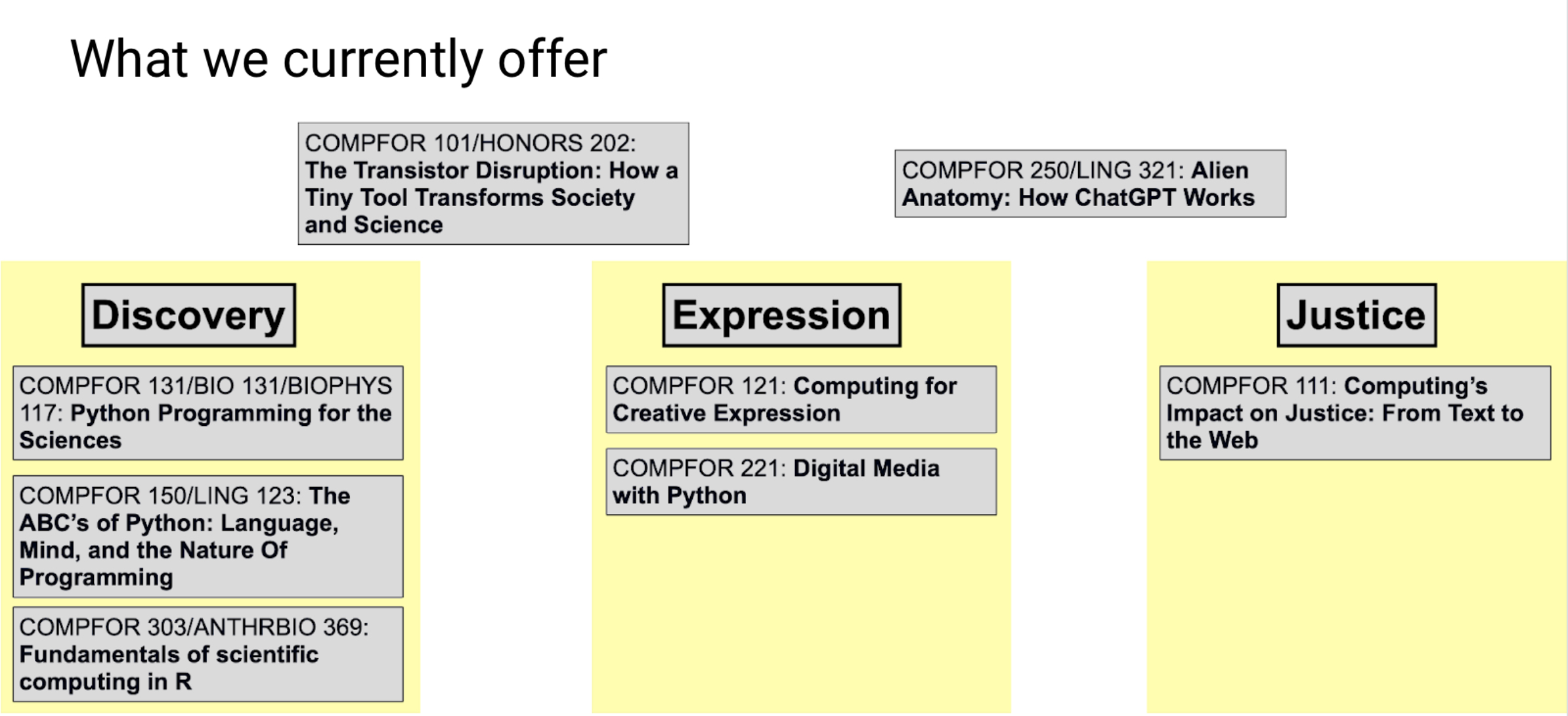
This semester, I’m teaching two brand new courses. That means that I’m creating them just ahead of the students. I did this in Fall 2022 for our first two courses (see links to the course pages here with a description of our participatory design process), and I hope to never do this again. It’s quite a sprint to always be generating material, all semester long, for about a hundred students.
One course is like the Media Computation course I developed at Georgia Tech, but in Python 3: COMPFOR 221: Digital Media with Python. The course title has changed. When we first offered it, we called it “Python Programming for Digital Media,” and at the end of registration, we had only five students enrolled! We sent out some surveys and found that we’d mis-named it. Students read “Python Programming” and skipped the rest. The class filled once we changed our messaging to emphasize Digital Media first.

When we taught Media Computation at Georgia Tech, we used Jython and our purpose-built IDE, JES. Today, there’s jes4py that provides the JES media API in Python 3. I had no idea how hard it was to install libraries in Python 3 today! I’m grateful to Ben Shapiro at U-W who helped me figure out a bunch of fixes for different installation problems (see our multi-page installation guide).
The second is more ambitious. It’s a course on Generative AI, with a particular focus on how it differs from human intelligence. We call it Alien Anatomy: How ChatGPT Works. It’s a special-topics course this semester, but in the future, it’ll be a 200-level (second year undergraduate) course with no pre-requisites open to all LSA students, so we’re relying on teaspoon languages and Snap! with a little Python. I’m team-teaching with Steve Abney, a computational linguist. Steve actually understands LLMs, and I knew very little. He’s been a patient teacher and a great partner on this. I’ve had to learn a lot, and we’re relying heavily on the great Generative AI Snap! projects that Jens Mönig has been creating, SciSnap from Eckart Modrow, and Ken Kahn’s blocks that provide an API to TensorFlow.
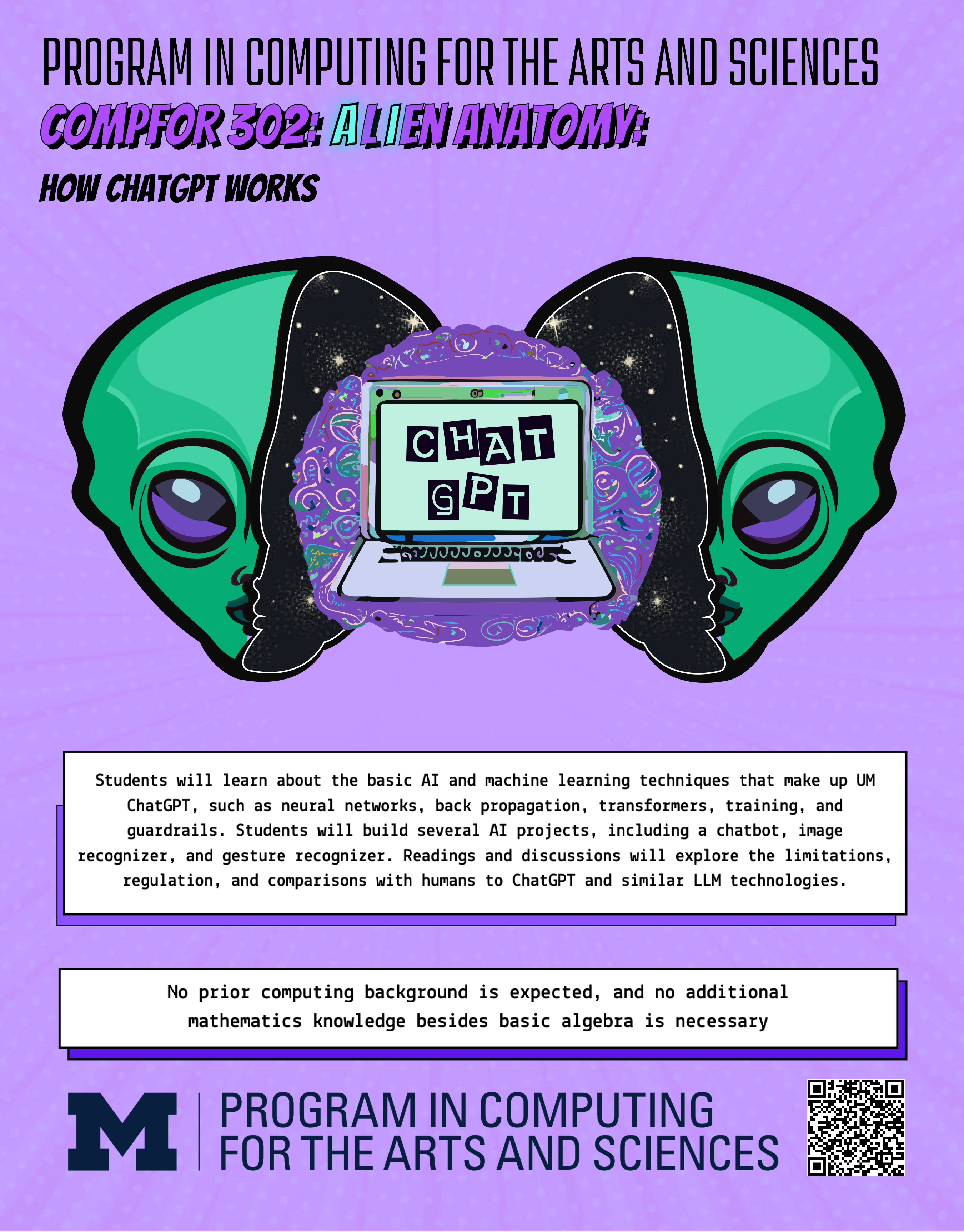
As of January, we are approved to offer two minors: Computing for Expression and Computing for Scientific Discovery. We have about a half dozen students enrolled so-far in the minors, which is pretty good for three months in.

PCAS Growth
When I offered the first two courses in Fall 2022, we had 11 students in Expression and 14 in Justice. Now, we’re up to 308 students enrolled. That’s probably our biggest challenge — managing growth and figuring out how to sustain it.
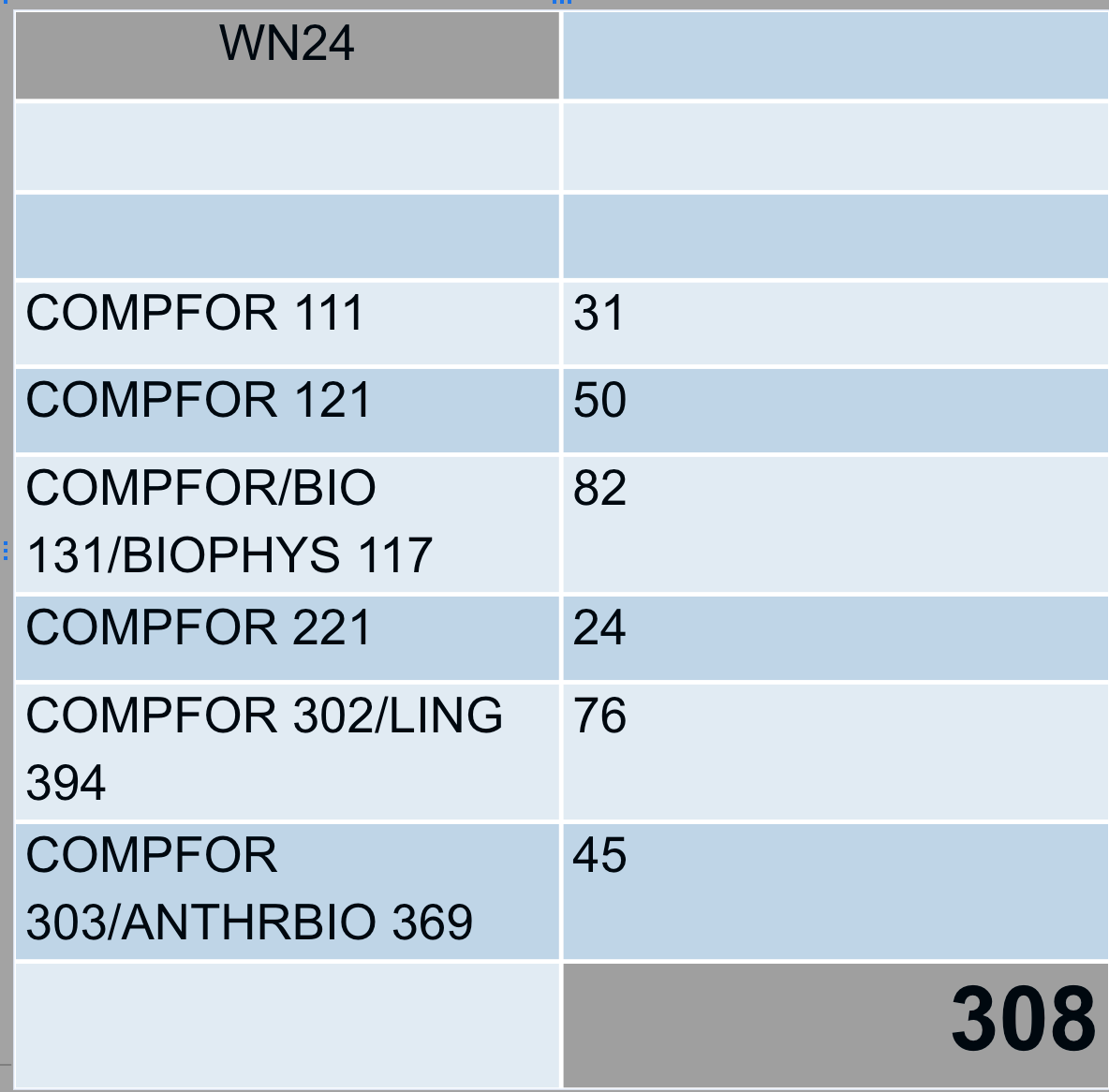
Research in PCAS
We’re starting to publish some of what we’re learning from PCAS. Last November, Gus Evrard and I published a paper at the Koli Calling International Conference on Computing Education Research about the process that we followed co-chairing the LSA Computing Education Task Force to figure out what LSA needed in computing education. That paper, Identifying the Computing Education Needs of Liberal Arts and Sciences Students, won a Best Discussion Paper Award. Here’s Gus and me at the conference banquet when we got our award.
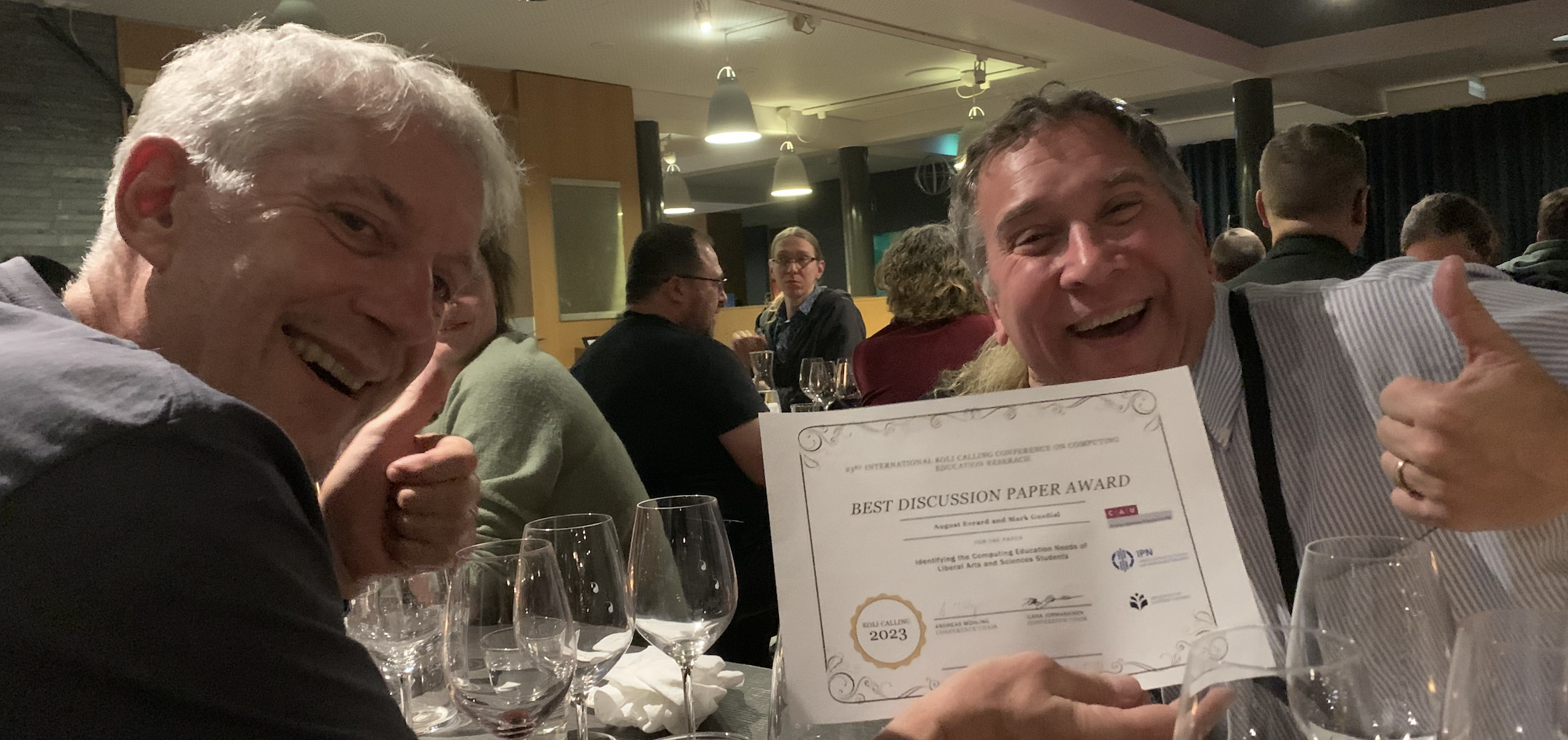
Tamara Nelson-Fromm just presented a paper at the 2024 PLATEAU Workshop on evidence we have suggesting transfer of learning from teaspoon languages into our custom Snap! blocks. I’ll wait until those papers are released to tell you more about that.
SIGCSE 2024 Presentations
We’re pretty busy at SIGCSE 2024, and almost all of our presentations are connected to PCAS.
Thursday morning, I’m on a panel led by Kate Lehman on “Re-Making CS Departments for Generation CS” 10:45 – 12:00 at Oregon Ballroom 203. This is going to be a hardball panel. Yes, we’ll talk about radical change, but be warned that Aman and I are on the far end of the spectrum. Aman is going to talk about burning down the current CS departments to start over. I’m going to talk about giving up on traditional CS departments ever addressing the needs of Generation CS (because they’re too busy doing something else) and that we need more new programs like PCAS. I’m looking forward to hear all the panelists — it’ll be a fun session.

Thursday just after lunch, Neil Brown and I are presenting our paper, Confidence vs Insight: Big and Rich Data in Computing Education Research 13:45 – 14:10 at Meeting Room D135. It’s an unusual computing education research paper because we’re making an argument, not offering an empirical study. We’re both annoyed at SIGCSE reviewers who ask for contextual information (Who were these students? What programming assignments were they working on? What was their school like?) from big (millions of points) data, and then complaining about small sample sizes from rich data with interviews, personal connections, and contextual information. In the paper, we make an argument about what are reasonable questions to ask about each kind of data. In the presentation, the gloves come off, and we show actual reviews. (There are also costumes.)
We don’t really get into why SIGCSE reviewers evaluate papers with criteria that don’t match the data, but I have a hypothesis. SIGCSE reviewers are almost all CS teachers, and they read a paper asking, “Does this impact how I teach? Does it tell me what I need to do in my class? Does it convince me to change?” Those questions are too short-sighted. We need papers that answer those questions to help us with our current problems, but we also need to have knowledge for the next set of problems (like when we start teaching entirely new groups of students). The right question for evaluating a computing education research paper is, “Does this tell the computing education research community (not you the reviewer, personally, based on your experience) something we didn’t know that’s worth knowing, maybe in the future?”
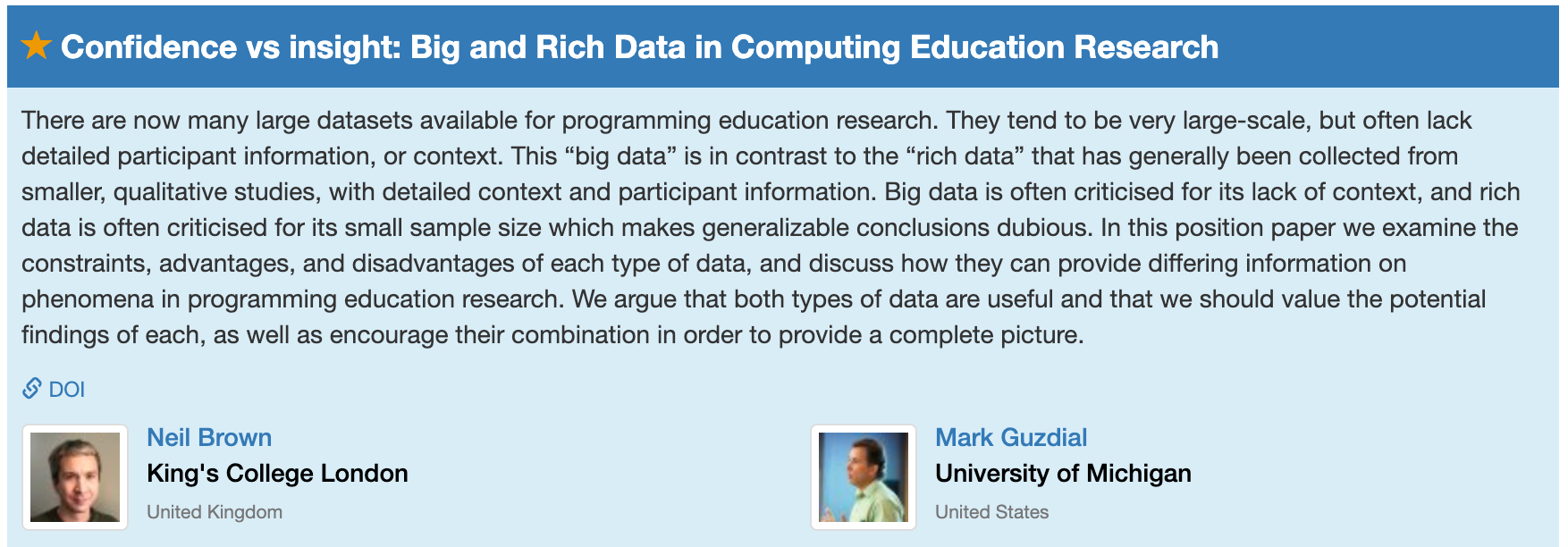
At the NSF Project Showcase Thursday 15:45 – 17:00 at Meeting Rooms E143-144, Tamara Nelson-Fromm is going to show where we are on our Discrete Mathematics project. She’ll demonstrate and share links to our ebooks for solving counting problems with Python and with one of our teaspoon languages, Counting Sheets.
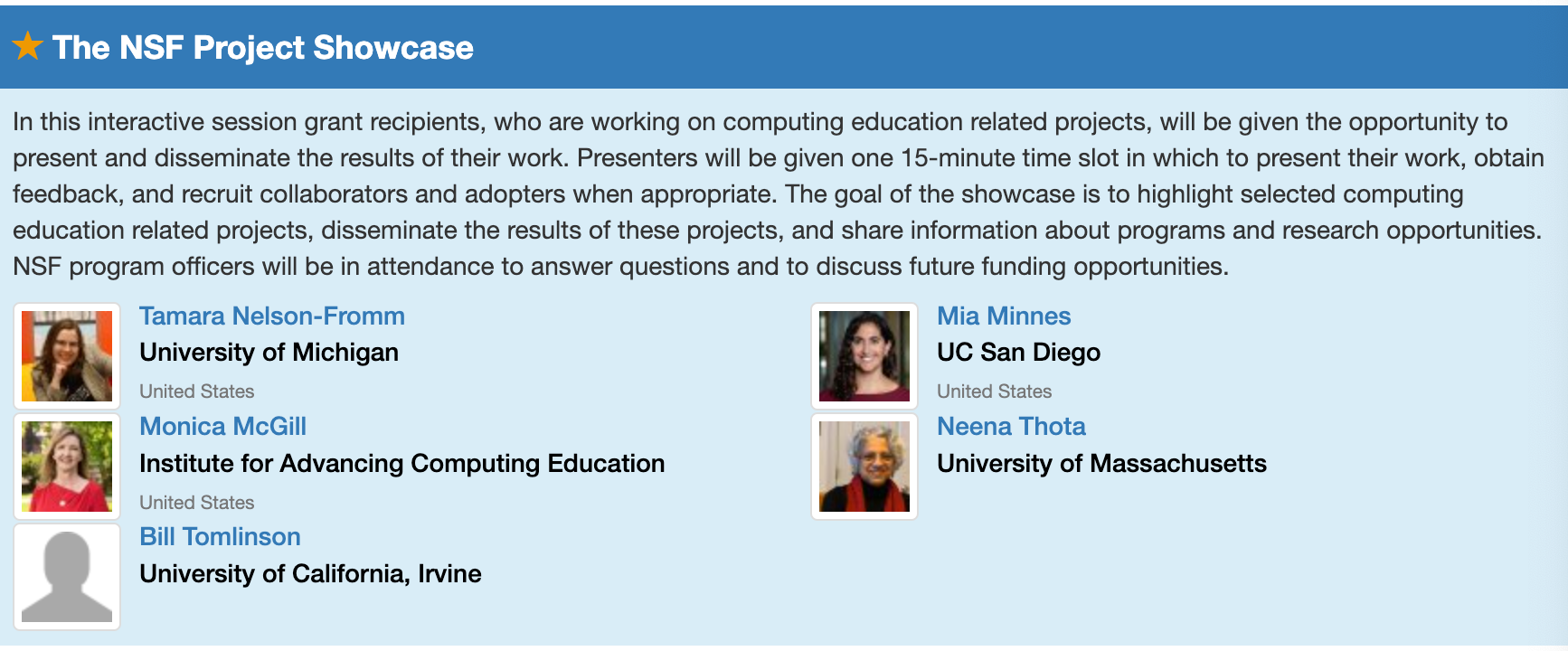
In the “second flock” of Birds of a Feather sessions Thursday 18:30 – 19:20 at Meeting Room D136, we’re going to be a part of Zach Dodd’s group on “Computing as a University Graduation Requirement”. There’s a real movement towards building out computing courses for everyone, not just CS majors, as we’re doing in PCAS. Zach is pushing further, for a general education requirement. I’m excited for the session to hear what everyone is doing.

On Saturday afternoon 15:30 – 18:30 at Meeting Rooms B113, I’ll offer a three-hour workshop on how we teach in our PCAS courses for arts and humanities students, with teaspoon languages, custom Snap! blocks, and ebooks. Brian Miller has been teaching these courses this year, and he’s kindly letting me share the materials he’s been developing — he’s made some great improvements over what I did. This workshop was inspired by a comment from Joshua Paley in response to our initial posts about how we’re teaching, where he asked if I’d do a SIGCSE workshop on how we’re teaching PCAS. Will do it on Saturday!

What Humanities Scholars Want Students To Know About the Internet: Alternative Paths for Alternative Endpoints
After we got the go-ahead to start developing PCAS (see an update on PCAS here), I had meetings with a wide range of liberal arts and sciences faculty. I’d ask faculty how they used computing in their work and what they wanted their students to know about computing. Some faculty had suggested that I talk to history professor, LaKisha Michelle Simmons. I met with her in January 2023, and she changed how I thought about what we were doing in PCAS.
I told her that I’d heard that she built websites to explain history research to the general public, and she stopped me. “No, no —- my students build websites. I don’t built websites.” I asked her what she would like her students to know about the Internet. “I could teach them about how the Internet works with packets and IP addresses. I could explain about servers and domain names.”
She said no. She was less interested in how the Internet worked. She had three specific things she wanted me to teach students.
- She wanted students to know that there are things called databases.
- That databases, if they are designed well, are easy to index and to find information in.
- Databases could be used to automatically generate Web pages.
Her list explains a huge part of the Web, but was completely orthogonal to what I was thinking about teaching. She wasn’t asking me to teach tools. She wanted me to teach fundamental concepts. She wanted students to have understanding about a set of technologies and ideas, and the students really didn’t need IP addresses and packets to understand them.
The important insight for me was that the computing that she was asking for was a reasonable set, but different from what we normally teach. These are advanced CS ideas in most undergraduate programs, typically coming after a lot of data structures and algorithms. From her perspective, these were fundamental ideas. She didn’t see the need for the stuff we normally teach first.
I put learning objectives related to her points on the whiteboards in my participatory design sessions. This showed up in the upper-right hand corner of the Justice class whiteboard — the most important learning objective. LaKisha gave me the learning objectives, and the humanities scholars who advised me supported what she said. This became a top priority for our class Computing’s Impact on Justice: From Text to the Web.
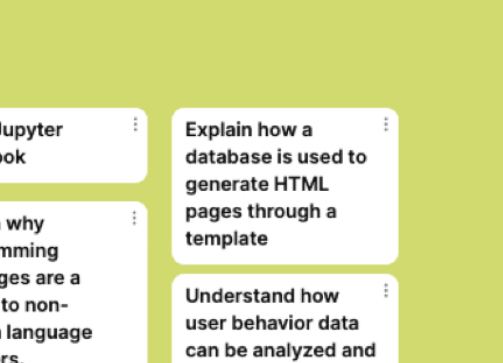
Figuring out how
During the summer of 2022, a PhD student working with me, Tamara Nelson-Fromm, a group of undergraduate assistants, and I worked at figuring out how to achieve these goals. We had to figure out how to have students work with LaKisha’s three learning objectives, without complicated tools. We were committed to having students program and construct things — we didn’t want this to be a lecture and concepts-only class.
We were already planning on using Snap, and it has built-in support for working with CSV files. Undergraduate Fuchun Wang created a great set of blocks explicitly designed to look like SQL for manipulating CSV files. We used these blocks to talk about queries and database design in the class.
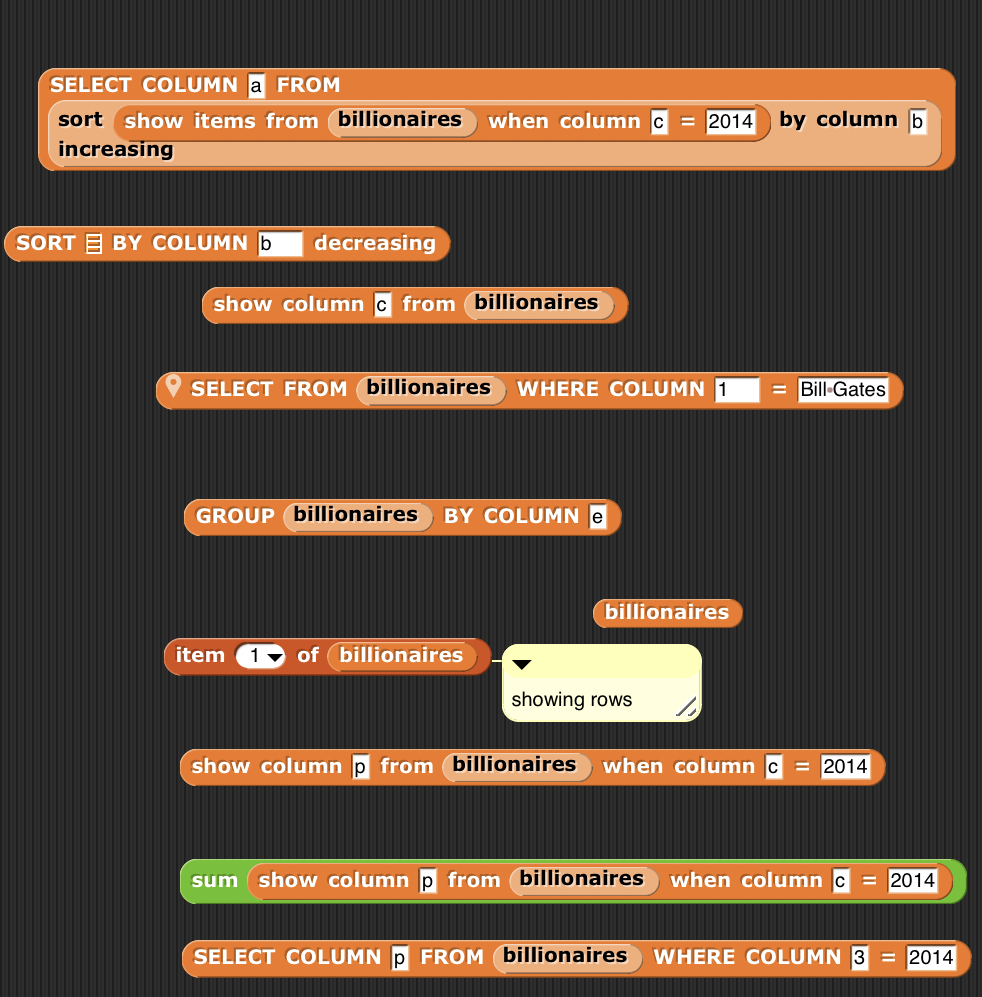
Tamara and I talked a lot about how to make the HTML part work. I had promised our advisors that we would not require LSA students to install anything on their computers in the intro courses. We talked about the possibility of building a teaspoon language for Web page development and for use as templating tool for databases, but I was worried that we were already throwing so many languages at the students.
Then it occurred to us that we could do this all with Snap. We built a set of blocks to represent the structure of an HTML page, like in this example. Since we could define our own control structures in HTML, we could present the pieces of a Web page nested inside other blocks, to mirror the nested structure of the tags.
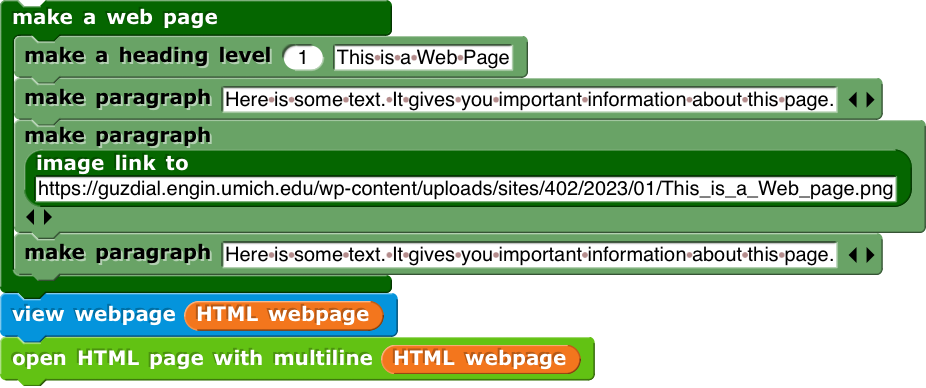
Those last two blocks were key. The view webpage block displays in the stage the first 50 lines of the input HTML. That’s important so that students see the mapping from blocks to HTML. The open HTML page block opens a browser window and renders the HTML into it. (That was a tricky hack to get working.)
This was enough for us to talk about building Web pages in Snap, viewing the HTML, then rendering the HTML in the browser. Here’s a slide from the class. In deciding what computer science ideas to emphasize, I used the work of Tom Park who studied student errors in HTML and CSS, and found that ideas of hierarchy and encapsulation were a major source of error. Those are important ideas across computing, so I used those as themes across the CS instruction — and the structure we could build in the Snap block helped to present those ideas.

All of that together is enough to build Web pages from database queries. Here’s an example — querying the billionaires database from Forbes for those from Microsoft, then creating a Web page form letter asking them for money.

We use these blocks in both of our classes:
- In the Justice class, students use the HTML blocks to create a resume for a fictional or historical character in a homework assignment. In a bigger project, students design their own database of anything they want, then create two queries. One should return 1-3 items, and should generate a detail page for each of those items. The second query should return several items, and return an overview page for that set of items.
- In the Expression class, building an HTML page is the last homework. They use style rules and have to embed a Snap project so that there’s interactivity in the page. Here’s a slide from the class where we’re showing how adding style rules changes the look-and-feel of an HTML page.

Alternative Paths to Alternative Endpoints
Mike Tissenbaum, David Weintrop, Nathan Holbert, and Tammy Clegg have a paper that I really like called “The case for alternative endpoints in computing education” (BJET link, UIUC repository link). They argue “for why we need more and diverse endpoints to computing education. That many possible endpoints for computing education can be more inclusive, just and equitable than software engineering.” I strongly agree with them, but I learned from this process that there are also alternative paths.
Computer science sequences don’t usually start with databases, HTML, and building web pages from database queries, but that’s what my humanities scholars advisors wanted. Computer science usually starts from algorithms, data structures, and writing robust and secure code, which our scholars did not want. Our PCAS courses are certainly about alternative endpoints — we’re not preparing students to be professional software developers. We’re also showing that we can start from a different place, and introduce “advanced” ideas even in the first class. Computing education isn’t a sequence — it’s a network.
Participatory Design to Set Standards for PCAS Courses
My main activity for the last year has been building two new courses for our new Program in Computing for the Arts and Sciences (PCAS), which I’ve blogged about recently here (with video of a talk about PCAS) and here where I described our launch. Here are the detailed pages describing the courses (e.g., including assignments and examples of students’ work):
- COMPFOR 121: Computing for Creative Expression
- COMPFOR 111: Computing’s Impact on Justice: From Text to the Web
When we got the go-ahead to start developing PCAS last year, the first question was, “Well, what should we teach?” The ACM/IEEE Computing Curriculum volumes weren’t going to be much help. They’re answering the question “What do CS, Software Engineering, Information Technology, etc. majors need to know?” They’re not answering the question, “What do students in liberal arts and sciences need to know about Computing for Discovery, for Expression, and for Justice?”
My starting place was the Computing Education Task Force (CETF) report (see link here) which summarized dozens of hours of interviews and survey results from over 100 faculty. We decided that the first two courses would be on Expression and Justice. There already were classes that introduced programming in a Discovery framing in some places on campus (and my colleague, Gus Evrard, has taken that even farther now — but that’s another blog post). There was nothing for first year students to introduce them to coding in an Expression or Justice context.
When faced with a design problem, I often think “WWBD” — “What Would Betsy Do.” I learned about participatory design working with Betsy DiSalvo at Georgia Tech, and now I reach for those methods often. I created participatory design activities so that Expression and Justice faculty in our College of Literature, Science, and the Arts (LSA) could set the standards for these courses.
I created three Padlets, shared digital whiteboards. A group of people edit a whiteboard, and everyone can see everyone else’s edits.
- One of them was filled with about 20 learning goals derived from the CETF report. These aren’t well-formed learning goals (e.g., not always framed in terms of what students should be able to do). These were what people said when we asked them “What should students in LSA learn about computing?” I wasn’t particularly thorough about this — I just grabbed a bunch that interested me when I reviewed the document and thought about what I might teach.
- I created two more Padlets with possible learning activities for students in these classes. Yvette Granata had recommended several books to me on coding in Expression and Justice contexts, so a lot of the project ideas came out of those. These were things that I was actively considering for the courses.
I ran two big sessions (with some 1:1 discussions afterwards with advisors who couldn’t make the big sessions), one for Expression and one for Justice. These were on-line (via Zoom) with me, Aadarsh Padiyath (PhD student working with me and Barbara Ericson), and a set of advisors. The advisors were faculty who self-identified as working in Computing for Expression or Computing for Justice. The design sessions had the same format.
- I gave the advisors a copy of the learning goals Padlet. (Each session started with the same starting position.) I asked them as a group to move to the right those learning goals they wanted in the class and to move to the left those learning goals that they thought were less important. They did this activity over about 20-30 minutes, talking through their rationale and negotiating placement left-to-right.
- I then gave the advisors a copy of the learning activities Padlet. Again, I asked them to sort them right is important and left is less important.. Again, about 20-30 minutes with lots of discussion.
We got transcripts from the discussion, and Aadarsh produced a terrific set of notes from each session. These were my standards for these courses. This guided me in deciding what goes in and what to de-emphasize in the courses.
Below are the end states of the shared whiteboards. There’s a lot in here. Three things I find interesting:
- Notice where the computer science goals like “Write secure, safe, and robust code” end up.
- Notice what’s in the upper-right corner — I was surprised in both cases.
- Notice that building chatbots is right-shifted for both Expression and Justice. Today, you’d say “Well, of course! ChatGPT!” But I held these sessions in February of 2022. The classes have a lot about chatbots in them, and that put us in a good place for integrating discussions about LLMSs this last semester.
Expression Learning Goals
(To see the full-res version, right-click/control-click on the picture, and open the image a new tab.)
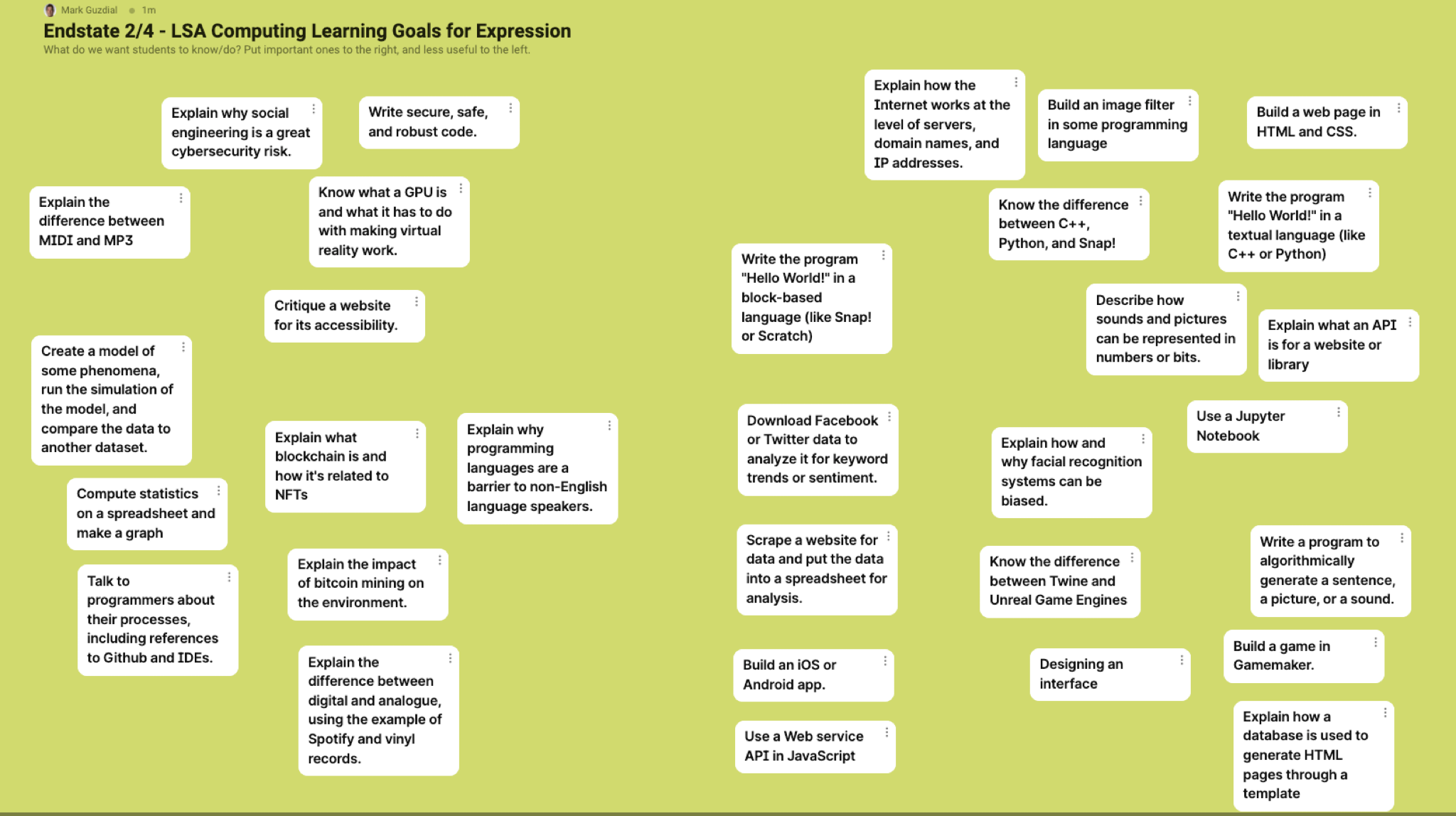
Justice Learning Goals

Expression – Learning Activities

Justice – Learning Activities

These are Standards
The best description of how I used these whiteboards and the discussion notes is that these are my standards. My advisors said very clearly during the sessions — there are too many learning objectives and activities for one course here. Things on the left are not unimportant. They’re just not as important.. I can’t possibly get to everything on these whiteboards in a single semester class designed for arts and humanities students (as the primary audience) with no programming background and with some hesitancy about mathematics.
My advisors were designing in a vacuum. They weren’t going to actually teach this course. Most of them had never seen a course that tried to achieve these objectives for this student audience. So they told me (for Justice), “Yeah, use Jupyter notebooks, and teach HTML and databases and code, all in one semester. And don’t make students install anything on their computers — do it all in the browser.” But they didn’t really have an idea how this might work, or if it was possible. They also didn’t articulate, “You’ll probably to teach about data and iteration and conditionals in here, too.”
It was my job to use these standards as priorities, cover what I could, and fill in with the computer science knowledge to make these do-able. We are also using these to inform future classes, the next classes we make for PCAS. You can compare these whiteboards back up to the course pages at the top of this post to decide how well we did.
Overall, we use participatory design methods a lot as we design for PCAS, to get the input of faculty outside of CS, because these aren’t computer science classes. They are not CS0, CS1, or CS0.5, all of which presume a linear progression towards the goal of being a CS major. Yes, we’re teaching computer science knowledge and skills, but these are classes in Computing for Expression and Computing for Justice. The faculty in those areas are the authorities in what we should teach. They decide what’s important.
Side note: I’ve had these data for over a year, and even presented some of them in a poster at ITiCSE last year. I have trying to figure out how to share them. Maybe this could have been a peer-reviewed publication (conference or journal)? I don’t know. It’s a design activity, and I learned a lot from it, but I don’t know how to write about it as scholarship. I finally decided to write this blog post so that I could share the whole big Padlet whiteboards. Traditional publication venues would be unlikely to let me put these big pictures out there, but I can in a blog post.
My many thanks to my advisors for these classes: Yvette Granata, Catherine Griffiths, M. Remi Yergeau, Tony Bushner, Justin Schell, Jan Van den Bulck, Justin Joque, Sarita Schoenebeck , Nick Henricksen, Maggie Frye, Anne Cong-Huyen, and Matt Bui
Updates: Developing the University of Michigan LSA Program in Computing for the Arts and Science
This blog is pretty old. I started it in June 2009 — almost 13 years ago. The pace of posting has varied from every day (today, I can’t understand how I ever did that!) to once every couple of months (most recently). There are things happening around here that are worth sharing and might be valuable to some readers, but I’m not finding much time to write. So, the posts the rest of this week will be quick updates with links for more information.
During most of the pandemic, I co-chaired (with Gus Evrard, a Physics professor and computational cosmologist) the Computing Education Task Force (website) for the University of Michigan’s College of Literature, Science, and the Arts (LSA). LSA is huge — about 20K students. (I blogged about this effort in April of last year.) Our job was to figure out what LSA was doing in computing education, and what else was needed. Back in November, I talked here about the three themes that we identified as computing education in LSA:
- Computing for Discovery: Think computational science, or data science + modeling and simulation.
- Computing for Expression: Think chatbots to Pixar to social media to Media Computation.
- Computing for Justice: Think critical computing and everything that C.P. Snow and Peter Naur warned us about computing back in the 1960’s.
Our report was released last month. You can see the release statement here, and the full report here. It’s a big report, covering dozens of interviews, a hundred survey responses, and a huge effort searching over syllabi and course descriptions to find where computing is in LSA. We made recommendations about creating a new program, new courses, new majors and minors, and coordinating computing education across LSA.
Now, we’re in the next phase — acting on the recommendations. LSA bought me out of my teaching for this semester, and it’s my full-time job to define a computing education program for LSA and to create the first courses in the program. We’re calling it the Program for Computing in the Arts and Science (PCAS). I’m designing courses for the Computing for Expression and Computing for Justice themes, in an active dialogue (drawing on the participatory design methods I learned from Betsy DiSalvo) with advisors from across LSA. (There are courses in LSA that can serve as introductions to the Computing for Discovery theme, and Gus is leading the effort to coordinate them.) The plan is to put up the program this summer, and I’ll start teaching the new courses in the Fall.
Recent Comments